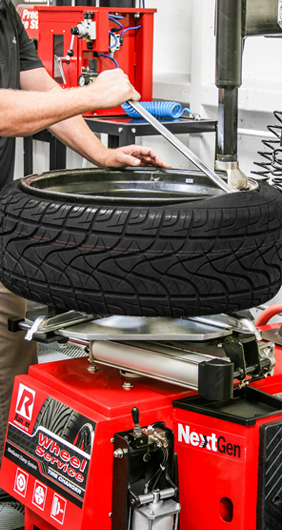Commercial truck owners can and, on occasion, do, save money by in-sourcing their tire dismount and mounting. Improper mounting can cost truck owners in a few different ways: Out of balance tires don’t drive easy and don’t wear well, hot beads unnecessarily deteriorate casing assets, and bad inflation pressure also accelerates tread wear, casing degradation, and wastes fuel and drive-train life.
Whether you retread your truck tires or not, the best thing to do is try and avoid damaging the bead when you take the tire off the wheel. If you do not retread, the tire dealer may refuse to purchase casings that have damaged beads. Some brands of casing do not have a chaffer ply in the bead, and we choose not to repair damage to this make’s beads. For further information contact your salesman or email us at, [email protected]. New bars, tire-soap, and taking small bites can help avoid dismount/mount-related bead damage.
Smaller bites with the tire bar help prevent bead damage
The flanges that the tire bead sits on on the rim should be cleaned with either a rotary wire wheel or a wire brush once a tread-life so that dried built/up bead grease does not generate friction which generates heat which will hasten the hardening of the rubber in the tire’s bead area. Mounting a new retread or steer tire on a dirty wheel is like putting dirty socks on a clean foot at the beginning of the day; by the end of the day, your feet will start to get sore. In the truck tire though, instead of your feet getting sore, the hard-brittle rubber in the bead becomes less pliable and more likely to split and crack.
It’s necessary to clean the wheel flanges
Truck tires are molded with a beauty ring around the sidewall about 3/8ths of an inch from the wheel. If the distance between this ring and the wheel edge is the same all the way around the wheel, the tire is seated on the wheel straight. Having the tire on the wheel as straight as possible reduces shimmy and vibration and is very important for tires that will be used on the steer axle.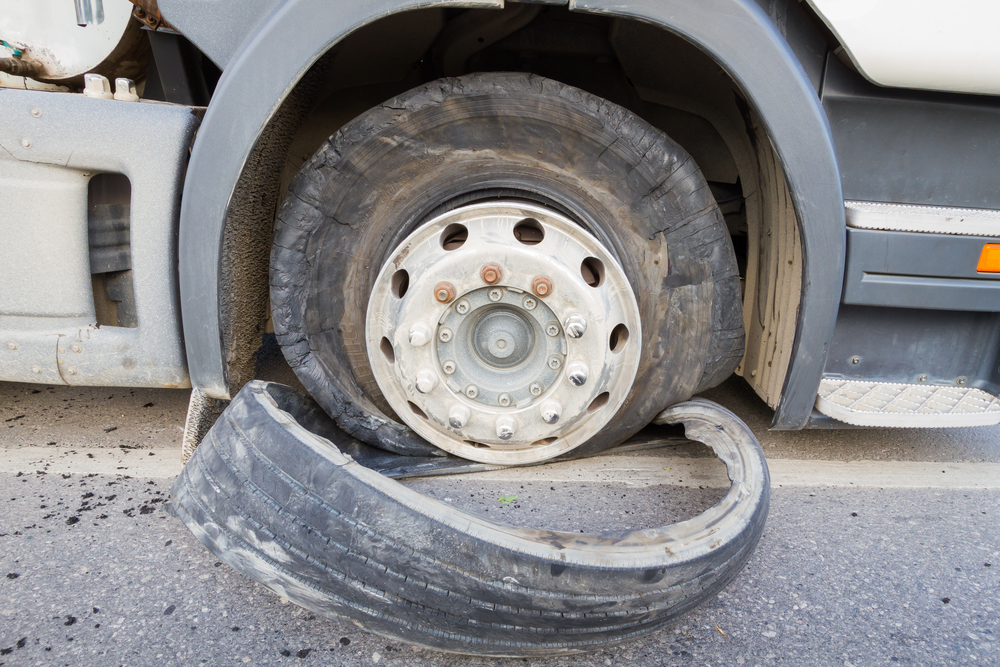 To ensure that the tire is straight on the wheel wet all of both beads with a tire-specific mounting lubricant. Chassis grease or diesel fuel are petroleum based and will react with the rubber in the tire and cause damage. It’s also necessary to lay the tire/wheel flat on the ground when starting the air. Failing to seat steer tires straight on the wheel can greatly impact wear-performance and driver comfort.
To ensure that the tire is straight on the wheel wet all of both beads with a tire-specific mounting lubricant. Chassis grease or diesel fuel are petroleum based and will react with the rubber in the tire and cause damage. It’s also necessary to lay the tire/wheel flat on the ground when starting the air. Failing to seat steer tires straight on the wheel can greatly impact wear-performance and driver comfort.
Your tire’s on square when the ring on the sidewall is the same width all the way around
Another best practice for mounting steer tires is to match the manufacturer’s low point with the valve stem. Manufacturer’s mark the light side of the tire with a painted yellow dot. This is best matched to the valve stem to eliminate vibration and maximize performance.
The dot on the new tire’s sidewall needs to align with the stem
In addition to cleaning the wheel with each tread-life, the small gasket that seals the valve stem to the wheel in a tubeless tire should be refreshed and changed out.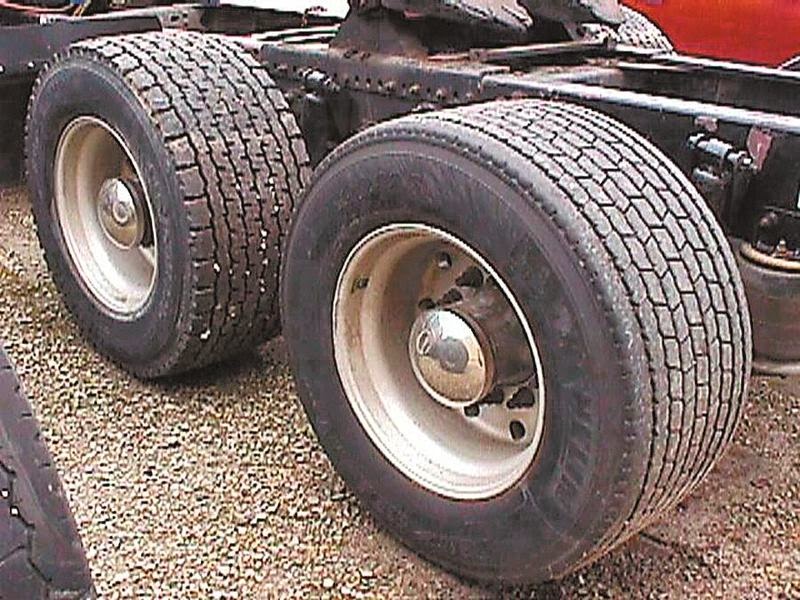 There’s no point in having a flat on your brand new tire because of a part the costs less than pennies.
There’s no point in having a flat on your brand new tire because of a part the costs less than pennies.
“for want of a nail”, change the valve stem gaskets!
Lastly, take the time to make sure that the air pressure your tire’s inflated to is exactly right. Always use a tire safety cage or have the tire and wheel bolted to the vehicle. When airing a tire that could have been ran under-inflated for an amount of time, look and listen for popping in the upper sidewall. A zipper will start popping, like popcorn being popped, before an explosive and potentially lethal rush of air will come shooting out of the sidewall of the tire. Get in a habit of not standing in the blast area of a tire as it’s inflating, or in other words, directly beside it. Hose extensions for filling tires with air with remote air gauges and tire cages and other supplies for doing tire work are available from companies like Myers, Borg, and Tech.
Thanks for reading!
It’s fine to use a pneumatic impact wrench to run the nuts up onto the studs, but always use a calibrated torque wrench for the final tightening procedure.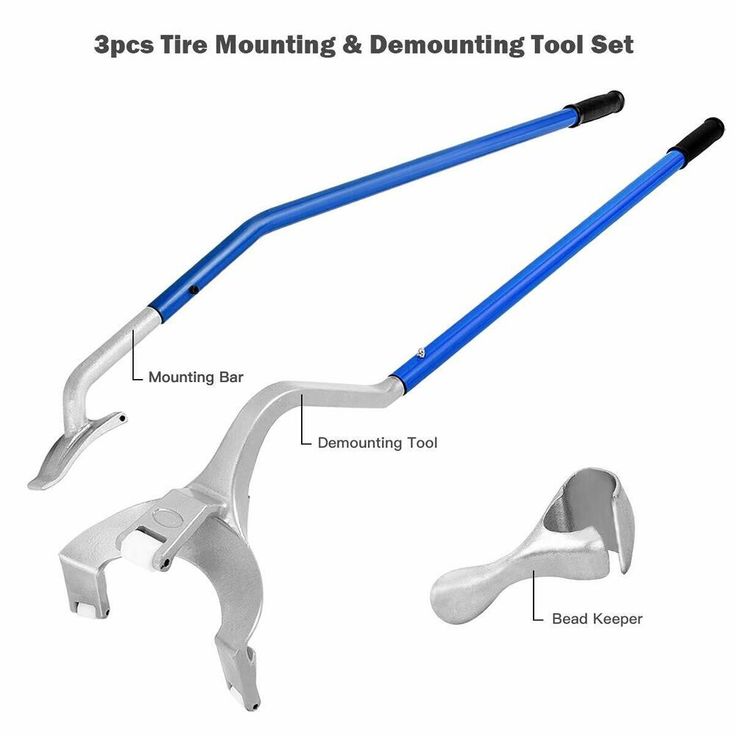
Photo: Jim Park
One seldom sees the words tire service and finesse in the same sentence, but proper mounting and installation of tires and wheels requires skill and precision — and indeed, a little finesse.
It’s one thing to wrestle the tire onto a wheel, air it up, and mount it on the truck. It’s quite another to make sure it’s concentrically mounted, the hub mounting face and the disc face of the rim are clean and rust-free, and the fasteners are properly torqued. Watch the folks servicing your tires to see if they are doing all this. If not, here are five things you might want to remind them are necessary for secure mounting, long tire life, and tire and wheel installer safety.
Inspect the rim for signs of damage, distorted shape, excessive corrosion, or any damage or irregularities in the rim bead seat, including rim flange wear. Carefully examine the wheel for cracks and worn or distorted stud holes. The mounting face of the disc wheel should be thoroughly gone over with a stiff wire brush to remove any rust, flaked metal, old paint, dirt and debris, etc. so it will fit flush against the mounting face of the hub.
so it will fit flush against the mounting face of the hub.
“Any contacting surfaces must be absolutely free of any material that can be compressed as the clamping force is applied,” says David Walters, manager of warranty and field service at Arconic, makers of Alcoa wheels. “Paint, rust or dirt will eventually wash away or fall out, reducing the clamping force. In particular, steel wheels that are painted are most susceptible. Corrosion of the steel and old paint can flake away.”
If the tire has a colored balance or runout dot on the sidewall, determine the meaning of the colored dot and mount the tire on the rim accordingly. Typically a yellow dot will align with the valve stem while a red dot will align with the dimple on steel wheels, but some tire makers use different colors.
With the rim and tire flat on the floor, apply a bead lubricant to help seat the tire. Never use a flammable liquid such as starting fluid to seat the tire bead to the rim. Inflate the tire to a minimum pressure to seal it and keep it in place on the rim.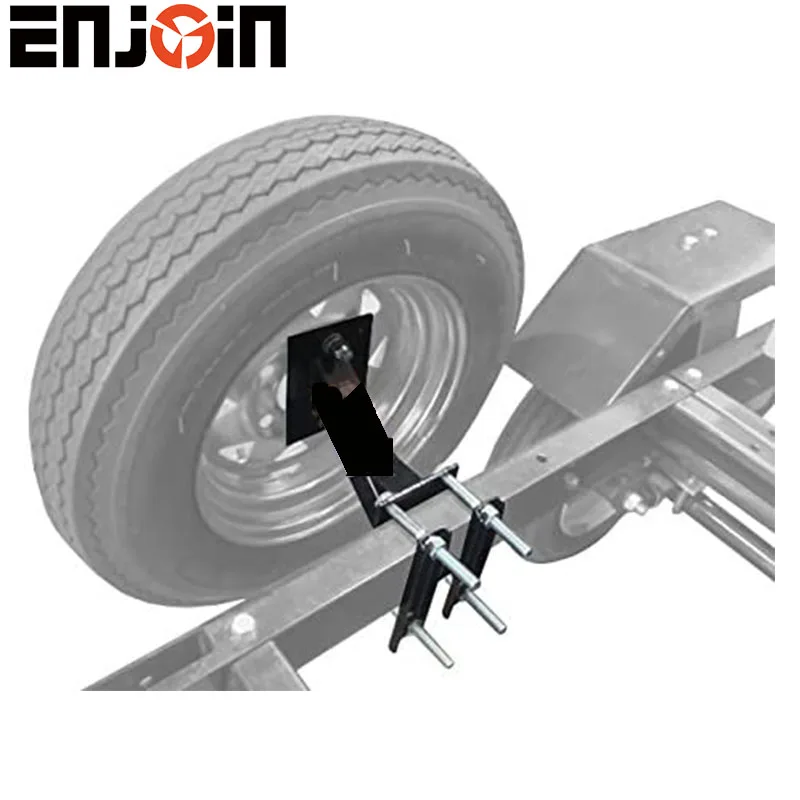
Once the tire is firmly seated, check to see that the distance between the rim flange and the aligning ring is uniform around the complete circumference of the tire. With the bead seated against the rim, the distance from the seating ring to the rim should be measured at four different points that are 90 degrees apart around the rim. The distance between the ring and the rim should be the same at all four points.
“Ensuring proper bead seating when mounting tires ensures optimal performance and tire life,” says Scott Green, B2B CES manager, Michelin North America. “An improperly seated bead creates uneven wear patterns and increases the chance for ride/vibration issues.”
With the bead seated against the rim, the distance from the seating ring to the rim should be measured at four different points that are 90 degrees apart around the rim.
Photo: Michelin
Technicians should verify the desired inflation pressure with either the tire manufacturer’s load and inflation table or the fleet’s preferred inflation pressure, usually based on tire type and wheel position. Before the tire is inflated, it must be rolled into an inflation cage for the safety of the installer and everyone else in proximity to the tire.
Before the tire is inflated, it must be rolled into an inflation cage for the safety of the installer and everyone else in proximity to the tire.
“Using certified and approved air-up safety cages, clip-on air chucks and calibrated regulators are a must,” says Bob Eck, TA Truck Service Commercial Tire Network vice president. “To provide added assurance that the casings will not rupture, allow 20 minutes at maximum pressure before the removing tire from the safety cage. There are no guarantees, however, since you cannot see what’s going on inside the tire during the inflation process. When using external cages, you can reduce the chances of injury by following proper procedures and keeping a safe distance from the tire.”
As with the mounting face on the wheel, ensure the hub mounting face is completely clean of old paint, rust, dirt, and other debris. Next, check and ensure the studs are not damaged, stretched, or badly corroded. The threads should be in good condition, have no paint or contaminants on them, and be the correct length and diameter for the type of wheel (aluminum or steel).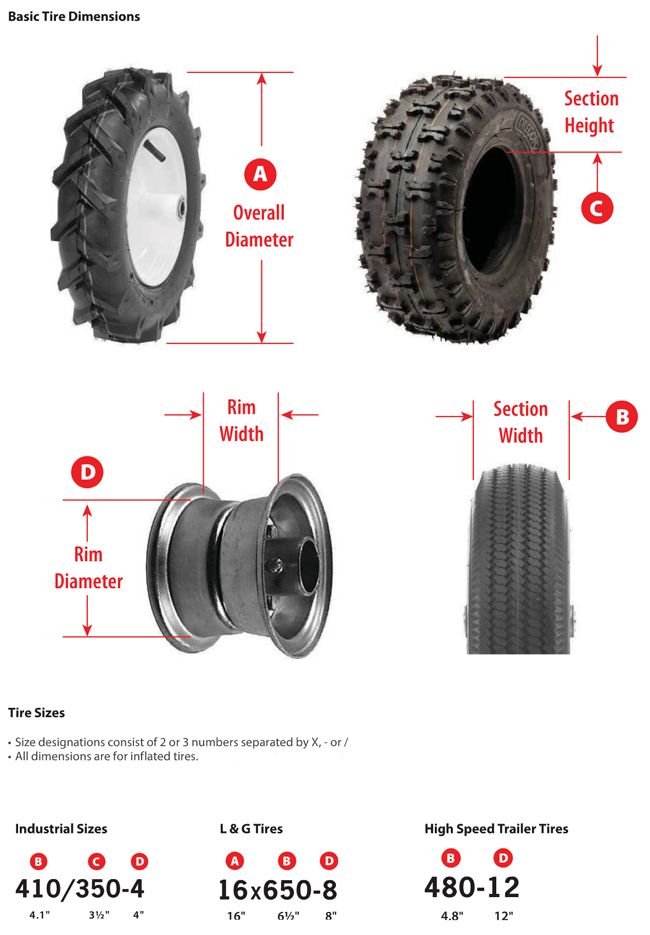 The threads must match the nuts, e.g., metric or English sizing.
The threads must match the nuts, e.g., metric or English sizing.
If you have to replace a damaged stud, the two adjacent studs should also be replaced. If you have two or more damaged studs, all 10 studs should be replaced with new hardware of the correct size and grade for the application.
“You do not have to replace all the studs each time you do a wheel installation,” says Brandon Uzarek, field engineer for wheels at Accuride Corp. “Good quality studs will last a long time, provided they have not been stretched or damaged. I have seen examples where you can rub the thread from the stud with your thumb. Studs like that obviously have to be replaced.”
Make sure there is no wear or damage to the hub pilots that would prevent concentric mounting of the wheel on the hub.
Before installing the nuts, place two or three drops of motor oil on the clean threads of the studs and one or two drops of motor oil between the washer and the nut on the two-piece flange nut.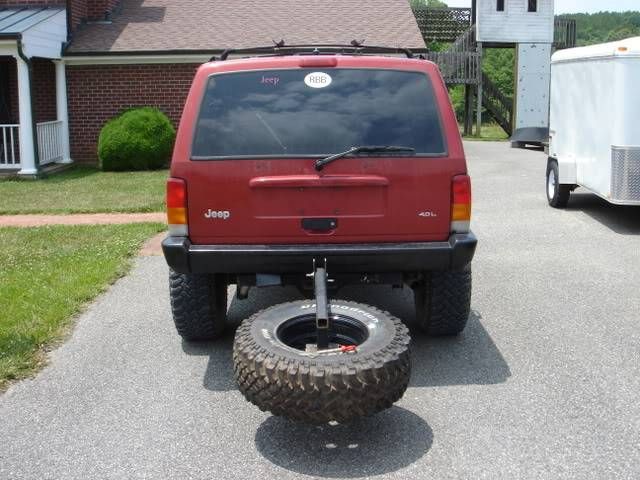 This reduces friction and allows you to achieve a desirable clamping force once the wheel is torqued down.
This reduces friction and allows you to achieve a desirable clamping force once the wheel is torqued down.
Ensure the two-piece flange nuts are in good condition and not seized between the nut and the flange. Run several nuts onto the studs using two or three drops of oil on the stud and between the washer and the nut on the two-piece flange nut. Use three or four nuts at light torque to hold the wheel in place on the hub and check for concentric mounting of the wheel on the hub. This will display as a high and low spot when rotating the wheel. Resolve the runout problem before installing and torqueing the remaining fasteners.
When mounting a pair of wheels in a dual assembly, ensure the diameter of the two tires is identical. Even a tiny difference can result in excessive scrubbing of the tires, causing premature wear.
Tires must always be placed in a certified tire cage before inflating them to working pressure.
Photo: Jim Park
Verify the correct torque requirements for the wheel being installed. The Technology & Maintenance Council’s Recommended Practice 237A, Torque Checking Guidelines for Disc Wheels, shows torque fastener recommendations ranging from 300 to 900 ft-lbs., depending on the wheel type, fastener, and procedure.
The Technology & Maintenance Council’s Recommended Practice 237A, Torque Checking Guidelines for Disc Wheels, shows torque fastener recommendations ranging from 300 to 900 ft-lbs., depending on the wheel type, fastener, and procedure.
“Always use calibrated torque wrenches to torque lug nuts to manufacturer-recommended specifications,” warns Eck. “Following manufacturer’s recommendations on proper torque will reduce the chances of a wheel-off and vehicle damage.”
Finally, check to ensure there is no side-to-side movement of the rotating assembly. Once the tire is installed, a runout gauge should be used to confirm the trueness of the wheel assembly.
If it’s not true, “its effect is to lead a vehicle alternately left and right as it rolls along, creating the perception of a shimmy or wobble,” says Green. “If it’s not running true, something is amiss. Don’t ignore this area. If you do, expect problems down the road.”
The final step in the process is to retorque the wheel nuts somewhere between 50 and 100 miles after a wheel has been installed.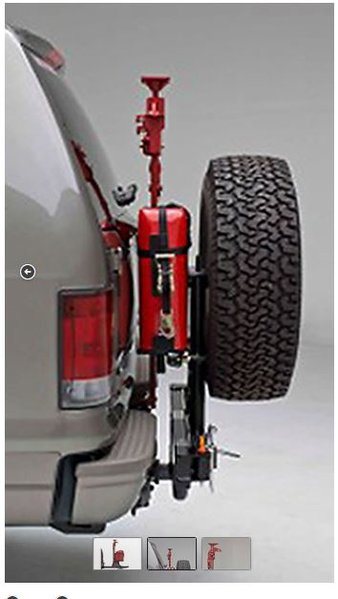 This is important because the wheel will settle into place during this period. Foreign matter may work its way out of the mounting surfaces, causing a loss of bolt tension and a loss of clamping force.
This is important because the wheel will settle into place during this period. Foreign matter may work its way out of the mounting surfaces, causing a loss of bolt tension and a loss of clamping force.
Installing tires and wheels isn’t all brute force, or at least it shouldn’t be. The final check and adjustment will help reduce irregular wear and possibly prevent a wheel separation. Both are well worth taking a little extra care during installation.
Answer Your Question
We're Open 24/7
24 Hours a Day
Open 7 Days a Week
7 Days a Week
Commercial Truck Owners Save Money by Booking Tire Removal and Installation. Improper installation can be costly to truck owners for several reasons: unbalanced tires ride poorly and wear poorly, hot beads unnecessarily degrade carcass performance, and poor inflation pressure also accelerates tread wear, carcass degradation and wasted fuel.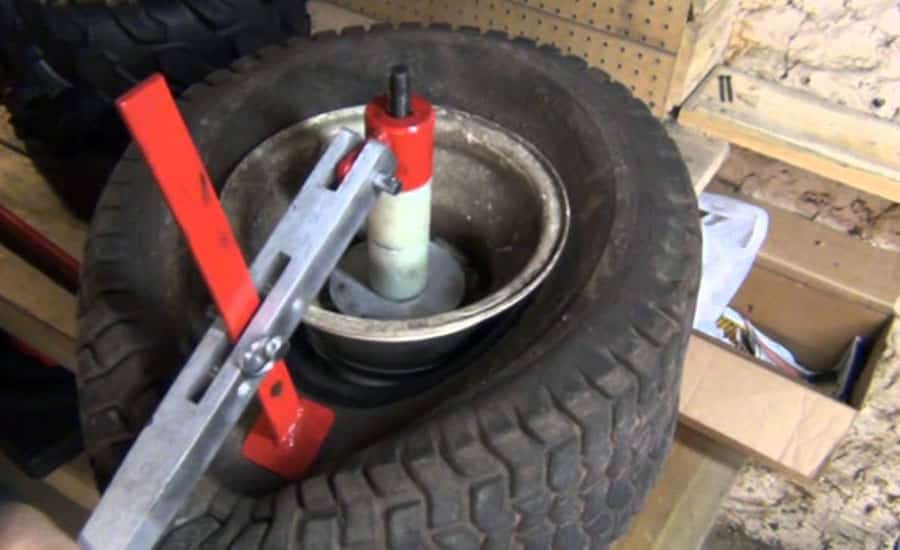 and transmission life.
and transmission life. Whether you are retreading truck tires or not, it is best to try not to damage the bead when you remove the tire from the wheel - at a 24-hour truck tire fitting (Dmitrovskoe shosse) this procedure is approached responsibly. If you don't retread, the tire dealer may refuse to buy frames with a damaged bead. Some brands of casings do not have a bead ring and it is preferable not to repair bead damage on such tires.
Putting a new retreaded or running tire on a dirty wheel is like putting dirty socks on a clean foot at the start of the day; by the end of the day, your feet will start to hurt. However, in truck tires, the hard, brittle rubber in the bead becomes less pliable and more likely to crack and crack.
Truck tires have a decorative ring around the sidewall about 2 cm from the rim. If the distance between this ring and the edge of the wheel is the same along the entire length of the wheel, the tire sits straight on the wheel (as they do at the service in the CAO). As straight a tire as possible on the wheel reduces noise and vibration, which is very important for tires that will be used on a steered axle.
To ensure that the tire sits directly on the wheel, moisten both beads with special mounting grease. Chassis lubricant or diesel fuel is petroleum based and will react with the rubber in the tire and cause damage. It is also necessary to put the tire / wheel on the ground when starting air traffic (recommended by craftsmen from the city of Dolgoprudny).
Incorrect fitting of the steered wheels to the wheel can greatly affect the wear resistance and comfort of the driver.
Another best way to install steer tires is to align the manufacturer's low point with the valve stem. The manufacturer marks the light side of the tire with yellow paint. It fits best on the valve stem to eliminate vibration and maximize performance. The point on the sidewall of the new tire should line up with the stem.
The manufacturer marks the light side of the tire with yellow paint. It fits best on the valve stem to eliminate vibration and maximize performance. The point on the sidewall of the new tire should line up with the stem.
In addition to cleaning the wheel at each tread life, the small gasket that connects the valve stem to the wheel in a tubeless tire needs to be renewed and replaced (as they do at a tire shop in Northeast Administrative District). There is no point in puncturing your brand new tire because the part is worth less than a penny.
Finally, make sure the air pressure your tire is inflated to is correct. Always use a tire cage when mounting a tire on a rim to a vehicle. When diagnosing a tire that may have been under-inflated for some time, look and listen for cracking in the upper sidewall.
Get in the habit of not standing in the blast zone of a tire when it is inflated, or in other words, right next to it. Hose extensions for inflating tires with remote gauges and tire covers, as well as other accessories for working with tires, can be purchased from specialized companies, cashless payment is available.
Hose extensions for inflating tires with remote gauges and tire covers, as well as other accessories for working with tires, can be purchased from specialized companies, cashless payment is available.
A truck tire is a complex piece of engineering, and it's also expensive. In total, only direct costs for truck tires and their operation account for up to 10% of the cost of a truck fleet, not to mention indirect ones (for example, such as excessive fuel consumption or losses from downtime). Therefore, we recommend choosing truck tires not emotionally, but rationally and consistently. This material will help you figure out what to pay attention to first.
Tire size
The recommended tire size for use is determined by the vehicle manufacturer, and it is the recommendations of the latter that you should pay attention to in the first place.
However, sometimes there is a legitimate need to change the tire size, for example, if the recommended size is rare and there are systematic problems finding tires (which causes the vehicle to idle).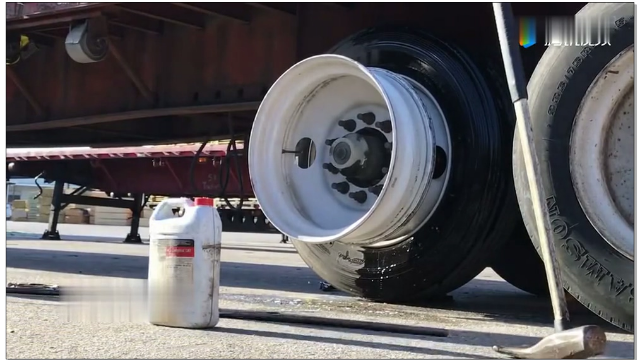 In this situation, we recommend that you do not rely on chance, consult with experts and, of course, make sure that the replacement tire model has the load index and speed index required for your vehicle.
In this situation, we recommend that you do not rely on chance, consult with experts and, of course, make sure that the replacement tire model has the load index and speed index required for your vehicle.
Location of tires on vehicle axles
Strictly adhere to the location of the truck tire for the intended use as specified by the tire manufacturer. Truck tires for universal use can be installed on any axle, but remember that:
We strongly advise against mounting trailer tires on a truck steering axle! The imaginary benefits of such a solution are more than “compensated” by the problems that arise in this case.
Truck tires of different designs (radial and diagonal) should never be used together on the same axle.
If a truck has conventional dual or single low-profile tires on the rear axle, both axles can be equipped with truck tires of the same design (either radial or diagonal), or tires of different designs can be used for each of the axles (radial tires per axle). , on the other - diagonal). If the vehicle has a single-wheel installation, then radial truck tires on the front axle can only be used if tires of the same design are installed on the rear axle. For four-wheel drive vehicles, all truck tires must be of the same design - either radial or diagonal.
For trailers and semi-trailers with one axle, both radial and diagonal truck tires can be used. Multi-axle trailers and semi-trailers allow the use of structurally mixed tires on different axles.
But truck tires on all axles of the drive axle must be either all radial or all diagonal.
Nature of transport
Truck tire manufacturers indicate areas of recommended tire use. During the design and manufacture of tires, elements are introduced into the design that optimize the characteristics of a truck tire for a specific use. Therefore, the use of tires for conditions that are not considered for this tire by the manufacturer will in most cases be disadvantageous.
During the design and manufacture of tires, elements are introduced into the design that optimize the characteristics of a truck tire for a specific use. Therefore, the use of tires for conditions that are not considered for this tire by the manufacturer will in most cases be disadvantageous.
Feel free to check with your supplier if the truck tires offered to you are suitable for the conditions in which they will work.
Economic feasibility
It would be wrong to assume that cheaper truck tires are more profitable. But the reverse is also not true.
For example, in particularly harsh conditions (when used at construction sites, in stone quarries, in landfills), even the most expensive tires of premium brands will fail quickly and will not provide tangible benefits compared to cheaper counterparts. And in long-haul transportation with a circle of flights of thousands of kilometers of good European roads, on the contrary, cheap tires can hardly oppose premium brands, whose tires show mileage of 500,000 km without cutting and retreading.
Therefore, the economic feasibility of a truck tire is determined solely by the cost per kilometer of tire mileage. It is this parameter that should be guided in choosing a specific brand and price segment. The ideal option is for you to evaluate the cost per kilometer of tire mileage not from the words of the seller, but according to your own usage statistics. To do this, it is necessary to establish a competent tire policy in the park. It requires some effort, but, believe me, it also gives good results.
And, by the way, if your supplier is not ready to talk about the cost per kilometer, is not ready to confirm the words with facts or reviews - there is a serious reason to think about whether they are offering you a pig in a poke.
The actions to be taken by truck drivers are very simple. In the company "City of tires" they are called "Smart system". This system includes the following principles:

High Mileage Recipe
The mileage of truck tires largely depends on their quality. But at the same time, drivers themselves can influence the results of walking.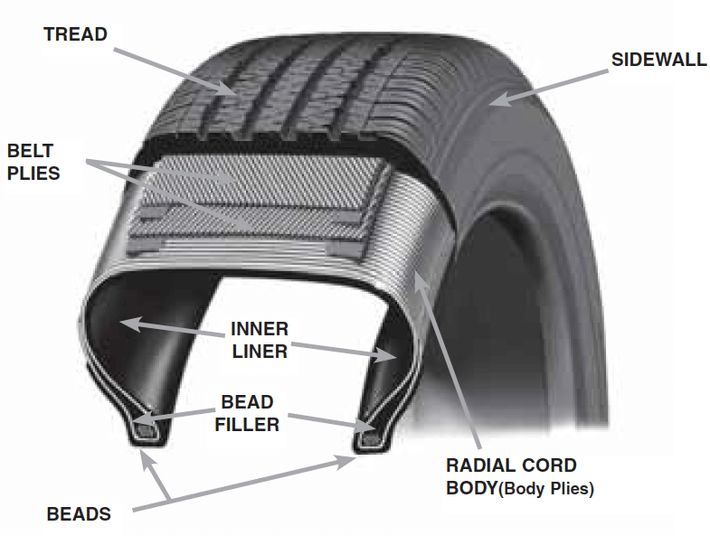 You just need to perform a series of actions that significantly extend the life of the tires.
You just need to perform a series of actions that significantly extend the life of the tires.
Starting with the purchase
Depending on where the car is used (road category) and what category of cargo is transported, the most appropriate tires (regional, main, etc.) are selected. On the highway, they require high wear resistance, in the city - a reinforced frame and sidewall structure, and for construction tires, a margin of safety and resistance to damage is relevant. If you do not pay attention to this, tires in inappropriate conditions will last less. Choosing the right tires is the first rule for your investment.
More attention
Very few people perform daily maintenance of truck tires. Well, why look once again into the wheels? Usually on the road, the driver inspects the tires for damage, and that's it.
And it would be necessary to check the uniformity of wear, remove foreign objects from the tread and measure the pressure. All it takes is 15 minutes, no more. But it will help, trust me.
All it takes is 15 minutes, no more. But it will help, trust me.
Curving
An aggressive driving style is never conducive to achieving maximum mileage. The drive axle truck tires are forced to constantly transmit high torque. Steering tires take on severe side loads when the car is cornering at high speeds. In addition, all tires of the road train are subjected to overloads during hard braking, which inevitably happens to the "racers". All this negatively affects the service life of tires: uneven wear appears (one-sided or two-sided - on steering tires, longitudinal comb - on drive tires), which, in fact, is a “reducer” of mileage.
Extra pounds
The manufacturer defines a load index for each truck tire. This means that the tire can only be loaded up to a certain limit. If this limit is exceeded, the bus may fail.
Given the condition of our roads, experts recommend buying truck tires with a load index of 10% more than expected.